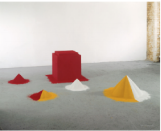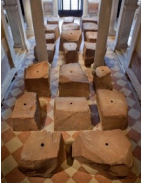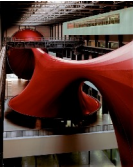Biography
Sir Anish Kapoor, CBE RA is a British-Indian sculptor born in Bombay in March 12, 1954. Famous for his
use of abstract biomorphic forms and his penchant for rich colours and polished surfaces, he was the first
living artist to be given a solo show at the Royal Academy of Arts in London.
 1000 Names
1000 Names
Born to a Hindu father and a Jewish mother from Baghdad, Kapoor had an Indian- Jewish upbringing. He
was educated in the prestigious all-boys boarding school, The Doon School in Dehradun, India and in 1971
moved to Israel to live in a kibbutz. He later began his study in electrical engineering and after finding out
that the discipline is not for him, he quit after 6 months. While in Israel he decided to become an artist, he
soon moved to Great Britain to attend Hornsey College of Art (1973-77) and Chelsea School of Art and Design (1977-78). He went on to teach at Wolverhampton Polytechnic in 1979
and in 1982 was Artist in Residence at the Walker Art Gallery in Liverpool.
During a return visit to India in 1979, he had sparked a new perspective on the
land of his birth and started on his early sculptures. Characterized by simple and
curved forms, usually monochromatic and brightly colored, he used powdered
pigment to define and percolate the architectural forms with the loose pigments
spilled beyond the object itself and onto the floor or wall. With this
methodology, Kapoor produced bodies of work such as 1000 Names which
became part of his first high-profile exhibit in the New Sculpture exhibition at
the Hayward Gallery London in 1978.
 Void Field (1990)
Void Field (1990)
In the 1980s, he became know for his geometric sculptures using materials such as
granite, limestone, marble, pigment, and plaster. His works begun to show his
explorations of matter and non-matter, specifically evoking the void in both freestanding sculptural works and ambitious installations. Many of his sculptures
seems to distort distance and space around them. By 1987, he was working with
quarried stones from which he carves cavities and apertures on in a play with the
dualities of nature. Kapoor's big break came in 1990 when he was chosen to
represent Great Britain at the Venice Biennale. His installation, Void Field,
received huge acclaim and catapulted him to prominence and recognition. His
success continued and in the following year he was honored the Turner Prize, a
prestigious award for contemporary art. With the accolades, he was increasingly
recognized and respected in the world of art.
Starting 1995, he has worked with the highly reflective surface of polished stainless steel. These works are
mirror like, reflecting or distorting the viewer and surroundings.
 Marsyas (2002)
Marsyas (2002)
The early 21st century marks Kapoor’s interest in addressing site and architecture
that led him to create projects that were increasingly ambitious in scale and
construction. He produced a number of large works, including Taratantara (1999),
Marsyas (2002) and Parabolic Waters (2000). For his 2002 installation Marsyas at
the Tate Modern gallery in London, Kapoor created a trumpet-like form by
erecting three massive steel rings joined by a 550-foot span of fleshy red plastic
membrane that stretched the length of the museum’s Turbine Hall. In 2004 Kapoor
unveiled Cloud Gate in Chicago’s Millennium Park; the 110-ton elliptical archway of
highly polished stainless steel—nicknamed “The Bean”—was his first permanent
site-specific installation in the United States. For just over a month in 2006, Kapoor’s Sky Mirror, was
installed in New York City’s Rockefeller Center. Both Cloud Gate and Sky Mirror reflected and
transformed their surroundings and demonstrated Kapoor’s ongoing investigation of material, form, and
space.1
He continued producing series of works in impressive scale, studying the paradox and duality of nature,
depth and perspective. His public commissions are both ambitious and extravagant straddling the lines
between architecture and art, the execution a feat in itself. Kapoor posited that his bodies of work are neither
pure sculpture nor pure architecture. He use the whole gamut of materials to express,"Immense PVC skins,
stretched or deflated; concave or convex mirrors whose reflections attract and swallow the viewer; recesses
carved in stone and pigmented so as to disappear: these voids and protrusions summon up deep-felt
metaphysical polarities of presence and absence, concealment and revelation. Forms turn themselves inside
out, womb-like, and materials are not painted but impregnated with colour, as if to negate the idea of an
outer surface, inviting the viewer to the inner reaches of the imagination.(...)"2 Kapoor also produced sitespecific work and performance-based installations. He continues to work with flair, using dramatic presence
and associations, continuing his interest in self-made objects. His vast and profound sculptural work has
been conceived for and on the scale of bodies, cities and the landscape, and the myriad contexts in which they
are located.
Recent solo exhibitions include Serralves Museum, Porto, Portugal (2018); 'Descension’' at Public Art Fund,
Brooklyn Bridge Park Pier 1, New York, NY, USA (2017); Parque de la Memoria, Buenos Aires, Argentina
(2017); MAST Foundation,Bologna, Italy (2017); Museo Universitario Arte Contemporáneo (MUAC),
Mexico City, Mexico (2016); Couvent de la Tourette, Eveux, France (2015); Château de Versailles,
France (2015) and The Jewish Museum and Tolerance Center, Moscow, Russia (2015). He represented
Britain at the 44th Venice Biennale in 1990 with Void Field (1989), for which he was awarded the Premio
Duemila for Best Young Artist. Kapoor won the Turner Prize in 1991 and has honorary fellowships from the
University of Wolverhampton, UK (1999), the Royal Institute of British Architecture, London, UK (2001)
and an honorary doctorate from the University of Oxford, UK (2014). Anish Kapoor was awarded a CBE in
2003 and a Knighthood in 2013 for services to visual arts. Large scale public projects include Cloud Gate

(2004) in Millenium Park, Chicago, USA and ArcelorMittal Orbit (2012) in the Queen Elizabeth Olympic
Park, London, UK.3
Text Reference:
1 Retrieved from https://www.britannica.com/biography/Anish-Kapoor
2 3 https://www.lissongallery.com/artists/anish-kapoor on September 20, 2018